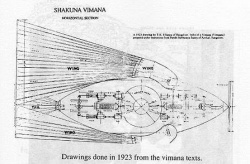What is a Vimana?
A vimāna is a mythological flying machine, described in the ancient literature of India.
References to these flying machines are commonplace in ancient Indian texts, even describing their use in warfare. As well as being able to fly within Earth's atmosphere, vimānas were also said to be able to travel into space and travel submerged underwater.
Descriptions in the Vedas and later Indian literature detail vimānas of various shapes and sizes:
In the Vedas: the sun, and flying wheeled chariots pulled by animals, usually horses (but the Vedic god Pūsan's chariot is pulled by goats).
The "agnihotra-vimāna" with two engines. (Agni means fire in Sanskrit.)
The "gaja-vimāna" with more engines. (Gaja means elephant in Sanskrit.)
Other types named after the kingfisher, ibis, and other animals.
The word comes from Sanskrit and seems to be vi-māna = "apart — having been measured".
Pushpaka Vimana in Hindu mythology was a vehicle that could fly in the air. It was basically a chariot that could soar the skies for long distances. It indicates that even in ancient times, people were curious about flight and might have attempted to design airborne vehicles.
The vehicle was originally created by Kubera, the God of wealth, but was later stolen, along with Lanka, by his half brother, the demon king, Ravana.
In later Indian writings: other flying vehicles, and sometimes as a poetic word for ordinary ground vehicles.
In some modern Indian languages (e.g. Gujarati), the word vimāna means ordinary real aircraft.
Some modern UFO enthusiasts have pointed to the Vimana as evidence for advanced technological civilizations in the distant past, or as support for the ancient astronaunt theory. Others have linked the flying machines to the legend of the Nine Unknown Men.
